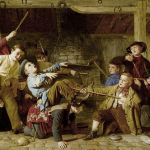 Miscellaneous
Miscellaneous  Miscellaneous
Miscellaneous  History
History 10 Huge Historical Events That Happened on Christmas Eve
 Music
Music 10 Surprising Origin Stories of Your Favorite Holiday Songs
 History
History 10 Less Than Jolly Events That Occurred on December 25
 Weird Stuff
Weird Stuff 10 Funny Ways That Researchers Overthink Christmas
 Politics
Politics 10 Political Scandals That Sent Crowds Into the Streets
 Weird Stuff
Weird Stuff Ten Bizarre Facts About The Doge Meme
 Our World
Our World 10 Ways Your Christmas Tree Is More Lit Than You Think
 Movies and TV
Movies and TV The 10 Coolest Stars to Set Sail on The Love Boat
 History
History 10 Things You Didn’t Know About the American National Anthem
 Miscellaneous
Miscellaneous Top 10 Things Crypto Was Supposed to Change & What Actually Did
 History
History 10 Huge Historical Events That Happened on Christmas Eve
 Music
Music 10 Surprising Origin Stories of Your Favorite Holiday Songs
Who's Behind Listverse?

Jamie Frater
Head Editor
Jamie founded Listverse due to an insatiable desire to share fascinating, obscure, and bizarre facts. He has been a guest speaker on numerous national radio and television stations and is a five time published author.
More About Us History
History 10 Less Than Jolly Events That Occurred on December 25
 Weird Stuff
Weird Stuff 10 Funny Ways That Researchers Overthink Christmas
 Politics
Politics 10 Political Scandals That Sent Crowds Into the Streets
 Weird Stuff
Weird Stuff Ten Bizarre Facts About The Doge Meme
 Our World
Our World 10 Ways Your Christmas Tree Is More Lit Than You Think
 Movies and TV
Movies and TV The 10 Coolest Stars to Set Sail on The Love Boat
 History
History 10 Things You Didn’t Know About the American National Anthem
Ten Horror Games Based on Reality
Horror games. Gotta love ’em. The chills they send down your spine as you immerse yourself in the horrifying environments they throw at you. Great times.
Until they’re not.
Until they’re real.
Sometimes, a horror game isn’t just a game. Here are 10 horror games that are based on real-life events. Stick around to the last one; it may be the most terrifying of them all.
Related: 10 Classic Horror Stories Inspired By True Events
10 Forbidden Siren
“First, an earthquake! Then the emergency siren! Then, the world as you knew it quickly evaporates into mayhem and evil. Find yourself in a fictional Japanese village in 1942 as villagers turn into zombies at alarming rates, and the sea around the village turns to blood and begins to engulf the town. You play as one of 10 different characters in your personal fight for survival. Play in areas like the school and an abandoned mine as you fight to stay alive and find the true cause of the evil forces around you. Horrifying sounds and visuals will get your heart pounding, and everything can change in the blink of an eye.”—Playstation’s official description on Amazon
Forbidden Siren, while it is a zombie horror game, is actually officially inspired by the true story of the Tsuyama Massacre. It was actually referenced in the game by making it the very reason the main character, Kyoya Suda, visits Hanuda in the first place. That reason? A soldier came to the village and murdered 33 people. The very same number that Mutsuo Toi killed and injured in Tsuyama.
Here’s the story:
Mutsuo Toi, a 21-year-old Japanese man, was born to a wealthy family in Kaio village next to another small town known as Tsuyama. Not long after he was born, his parents died from tuberculosis, and the remaining family left Toi with nothing to remember them by except the very same disease they died from. Toi was only able to hold onto his strong love for his sister and grandmother—the only family he had left. Unfortunately, good things don’t last, and after losing his sister to marriage, he became quite interested in crime novels and even began to write his own about a prostitute who strangled her lovers.
He also decided to practice in Yobai, Japan’s ancient answer to Tinder. This practice was done by sneaking into girls’ rooms at night buck naked to “teach them the secrets of love,” but for Toi, it was more of a horror movie than a friendly classroom lesson. His attempts at courtship were all met with rejection. Perhaps it was because he didn’t bring flowers, but it was probably because he still had tuberculosis.
And then came the fateful night of May 21, 1938, when Toi decided to give his neighbors a gift from his axe, katana, and his favorite Browning shotgun. Strapping two flashlights to his head, he decided he had enough rejection from his family and the small town of Tsuyama. First, his grandmother got an unexpected haircut, courtesy of Toi’s axe. At the same time, the neighbors received a visit they didn’t sign up for, complete with complimentary shotgun blasts and swordplay.
It wasn’t until dawn—with no intervention from law enforcement—that Mutsuo stopped massacring and shot himself in the chest with his favorite shotgun. But not before writing in his suicide note that he was sad that he didn’t kill more people and that he was glad to have killed his grandmother to stop the shame of being labeled a “killer’s grandma.”
The fact that the police confiscated his gun earlier for threatening to shoot up the town and did nothing other than that also definitely showed how helpful they were, as he just bought more weapons a few weeks later.
The Tsuyama massacre was considered the deadliest massacre until 1987, when the grim record was broken by Woo Beom-kon in South Korea.[1]
9 The Town of Light
“March 12, 1938, Renée, 16, was ripped out of her world; her only fault was that of not knowing her place in the world.”—The Town of Light’s official Steam description
The Town of Light is well known to be based on Volterra Psychiatric Hospital in Volterra, Italy.
As the player in the game, you are free to wander the halls of the asylum, solving puzzle after puzzle and being told about Renee’s traumatic stay in the hospital through illustrated animatics. In order to solve the puzzles, you have to look at the drawings and writings on the walls, all of which are references to the actual Volterra Asylum.
The Ospedale Psichiatrico di Volterra, an Italian mental institution shuttered in 1978, remains a haunting relic of bygone psychiatric practices. Founded in 1888, it housed thousands of patients subjected to barbaric treatments, including enough electroshock therapy to rival Dr. Frankenstein.
Notorious for its harsh conditions, the asylum’s Ferri pavilion, or judicial section, was especially grim. Patients, numbering up to 6,000 at a time, endured cramped quarters and dehumanizing practices. Electroshock therapy and insulin-induced comas were routine, while a manual of pills and poisons served as callous experimentation tools, causing permanent side effects to the patients.
Fernando Oreste Nannetti, known as NOF4 and another patient in the asylum, was known for his graffiti all over the walls of his cell. He used his belt buckle to make his mark on the asylum’s walls, creating an extensive mural chronicling his experiences during his hospitalization. Nannetti’s graffiti is a direct reference to the writing on the walls in the game.
The closure of the institution in 1978 followed the enactment of Law 180, signaling an end to the era of asylums and to the adoption of Italy’s public mental health system. Since then, the asylum’s physical decay has ironically begun to mirror the minds of its former patients.[2]
8 Visage
“Visage is a first-person psychological horror game. Explore a mysterious, ever-changing house in a slow-paced, atmospheric world that combines both uncannily comforting and horrifyingly realistic environments, and enjoy a genuinely terrifying experience.”—Visage’s official Steam page description
https://store.steampowered.com/app/594330/Visage/
Visage is a popular psychological horror game where the player goes about the house, unlocking chapter after chapter that tells the stories of those who lived there before. Visage is simply, in my opinion, one of the scariest horror games out there and one of my favorites. However, some of the stories in it are more real than you think.
Lucy, the first chapter of the story, is based on a girl named Anneliese. Anneliese’s story is also used as an inspiration for The Exorcist, so it has had its fair share of horror adaptations by this point.
Anneliese Michel’s story began with a diagnosis of temporal lobe epilepsy at 16, leading to a downward spiral of psychiatric treatment and medication. Despite her family’s religious upbringing, her condition deteriorated, marked by hallucinations and suicidal thoughts, and she even became aggravated and repulsed by crosses and the Bible scriptures.
By 1975, convinced she was possessed, Anneliese and her family turned to the Catholic Church for help, seeking permission for an exorcism. Annelise continued to exhibit disturbing signs such as seizures; she reported hearing voices in her head as she prayed that said she would “rot in hell.” She would eventually refuse to eat or drink anything except for her own urine and any insects she could find.
Her death in 1976, attributed to malnutrition and dehydration, led to charges of negligent homicide against her parents and the priests., Doctors were testifying that Anneliese’s symptoms were psychological rather than demonic. Church-paid lawyers battled back against the claims by saying that all church practices were legal and that religious people were free to practice their own forms of medicine. After the bloody battle of words and weaponizing of sympathy, the charges were all dropped, and the parents were free to go.
So give me your thoughts on the subject. Do you believe Anneliese was possessed or simply possessed a psychological problem?
Dwayne’s story, the last chapter of the game, was also allegedly based on the MK Ultra case as one of the leading scientists of the project. His own exposure to his creation caused his delusions and paranoia. We’ll dive deeper into that case at number 2.[3]
7 The Dark Pictures Anthology: The Devil in Me
“A group of documentary filmmakers receives a mysterious call inviting them to a modern-day replica of serial killer H.H. Holmes’ Murder Castle. But on arrival, they soon discover they’re being watched and even manipulated, and suddenly, there is much more at stake than just their ratings…”—The Devil in Me’s official Steam page description
Now, The Devil in Me is quite literally an adaptation of America’s first real-life serial killer, so there’s not much of a need to go into detail on how they relate. The only difference is—in the game, you can escape him.
H.H. Holmes, infamous for his “Murder Castle” during the 1893 Chicago World’s Fair, is often portrayed as one of America’s first serial killers, supposedly claiming up to 200 victims. However, recent research suggests a different narrative. Author Adam Selzer believes Holmes likely killed around nine people, with the exaggerated figure of 200 originating from a sensationalized 1940 book.
Contrary to popular belief, Holmes did not trap strangers in his hotel; rather, he targeted people he knew. His building wasn’t a functioning hotel but a scheme to defraud suppliers and investors. While his hotel horror show was debunked with recent evidence, his hotel was actually built as it was depicted.
Holmes’ “Murder Hotel” had over 100 rooms, sprawling across an entire city block like a spiderweb. With the first floor dedicated to storefronts, Holmes allegedly had a cunning plan to lure in unsuspecting entrepreneurs. Meanwhile, the third floor offered apartments for new guests in town. He sure gave them a very warm welcome, too.
The second floor held the real surprises—a maze of “asphyxiation chambers,” with gas pipes across the ceilings, hidden stairs, doors that led to brick walls, and other happy surprises. And for the unfortunate souls who ventured into the basement, well, let’s just say it wasn’t your typical laundry room. Holmes had turned it into his own personal chamber of horrors, complete with trapdoors and secret passages.
However, unlike the books, movies, and The Devil in Me, Holmes’s real victims, like Julia Connor and her daughter Pearl, had personal connections to him. Others, like Emeline Cigrand and Minnie Williams, disappeared under suspicious circumstances, possibly at Holmess’ hands. The murders of Ben Pitezel and his children, however, have more substantial evidence, leading to Holmes’s conviction and subsequent execution in 1896.[4]
6 Granny
“Welcome to Granny. Granny keeps you locked in her house. Now you have to try to get out of her house, but be careful and quiet. She hears everything. If you drop something on the floor, she hears it and comes running. You can hide in wardrobes or under beds.”—Granny’s official Google Play Store description
Tamara Samsonova was born in Uzhur, Russia, in 1947. “Sweet as sugar,” everyone called her. Fitting, as the smell of mustard gas is also sweet before it kills you. Tamara went on to graduate from Moscow State Linguistic University, landed a job in St. Petersburg, and married a guy named Alexi.
All seemed peaceful until Alexi suddenly went on a “spontaneous vacation” in 2000, according to Tamara. The St. Petersburg police spoke with Tamara on the matter, but with no evidence of foul play, they shrugged and moved on, leaving Tamara to herself—with some new hobbies.
Tamara eventually got lonely and decided to sublet her apartment. However, her roomies didn’t stick around for long. Her bad temper and aggressive attitude led to loud arguments that caught the attention of a few disgruntled neighbors. One roommate, Sergei, disappeared without a trace in 2003. However, no one batted an eyelash, as everyone she sublet to left within a few weeks. And, with Tamara’s love for axes and trying new foods, he was left to rest in pieces, some more digested than others.
Fast forward to 2015, Tamara’s feeling spry at 70 and decided to spruce up her apartment. Valentina, a neighbor, offered her couch during renovations. What started as a friendly gesture turned into a quarrel over dishes and, ultimately, Tamara’s inventive solution: a dose of Phenazepam and Valentina’s favorite salad topping. After cutting her up into pieces, she boiled her head and fingers so no one would be able to identify her body.
Police connected the dots to a string of unsolved disappearances, including one roommate, Sergei. Another, Volodya, survived Tamara’s culinary experiments, narrowly avoiding a poisoned fate.
Throughout her trial, Tamara remained cheerful and happily applauded the decisions the court made—even blowing a kiss at the cameramen. But why? Well, as she said, she wanted to be known as a serial killer and was “getting ready for this trial for dozens of years.”[5]
5 9 Childs Street
“This is a first-person indie horror game. In 9 Childs Street, you will find the terrifying atmosphere of a recently abandoned house and its captive inhabitants through the eyes of a curious little boy in a red cap.”—From 9 Childs Street’s official Steam page
9 Childs Street became a popular game download and playthrough for several YouTubers last year. The main character is a little boy who simply wants to see what happened to his missing neighbor in the abandoned house across the street and decides to find out for himself. Once in the house, however, he found a lot—and I mean a lot—of dolls that looked just a bit too realistic… especially when they moved.
However, I bet you never would have guessed that the entire background story is true, omitting some paranormal details, of course. Based on real-life Russian philologist-turned-grave-digger Anatoly Moskvin, later dubbed “The Dollmaker,” 9 Childs Street is a lot closer to reality than anyone would have ever wanted.
Moskvin became fascinated with the dead—specifically dead children—when he was also a child. His curiosity appeared when a funeral procession of a young girl was going by him, and some of the mourners walked up to him and demanded he kiss the dead young girl’s cold face. He reluctantly did so, awakening a morbid fascination in the process.
As Moskvin continued through life, he gained an attraction to cemeteries and freshly dug graves—which he would happily lie down in just to really soak in that corpse juice, I guess. Eventually, he began to rob these fresh graves of their corpses and carry them back to his parents’ house, focusing mostly on small young girls. He would then go on to mummify their corpses and turn them into dolls, usually wearing the very same clothes they were buried in.
By the time the police had linked the grave robberies back to Moskvin in 2011, he had turned 29 corpses into dolls. His reasoning? Well, it was entirely reasonable, really. He simply adored children and always wanted some of his own. He would even sometimes set the dolls up toward the TV with cartoons playing, sing songs, and read books to them so that they could still continue playing as they would have when they were alive. Wouldn’t have done anything differently myself, honestly.[6]
4 Evil Nun
“After receiving a mysterious invitation to a summer camp, you are captured by Sister Madeline inside Eagle’s Junior High School. Now, your mission is to escape the school before Sister Madeline manages to complete her evil plan. Explore the school as you escape from Sister Madeline in your quest to regain your freedom. Solve puzzles and challenges until you find one of the multiple escape routes in the game. Discover the secrets hidden in the laundry room and the mysterious boy with blue hands to complete the game 100%.”—Official Google Play description
The Evil Nun became known as a crazier rip-off of Granny, which we already talked about. And—similar to Granny—it’s also based on a real horror story.
Marie Hargreaves was just six years old when she was given to a convent. What was supposed to give her and her brother better living conditions than that with her family became a disastrous nightmare that would traumatize her for years to come. Fortunately, her brother was placed in a different area and was spared from the same treatment.
This convent was run by a nun named Isobel O’Brien, our Sister Madeline in the game, who would ritualistically beat Marie or encourage the other girls in the convent to beat her with wooden clothes hangers. Every girl who tried to escape from the prison would be tied to the bed after being dragged back by their hair. The girls were also made to do chores and basically do free labor for the Roman Catholic Church and would be woken up at 6 am sharp every morning. Marie was beaten if she spoke without permission, didn’t finish her food, or simply looked at the nun the wrong way. She was also told that she was an orphan and that her parents had died and abandoned her to live there.
If the mental and physical abuse wasn’t enough, the 12- and 13- 13-year-old girls that surrounded her also sexually abused her. However, she didn’t recognize it as such until she got out a few years later.
Sister O’Brien had been complained about multiple times before to the Catholic Church, but nothing had been done. Marie ended up speaking out and writing a book about her experience called The Convent, but at that point, the evil nun had died, and no justice could be served.[7]
3 Resident Evil Village
“Experience survival horror like never before in the 8th major installment in the Resident Evil franchise—Resident Evil Village. With detailed graphics, intense first-person action, and masterful storytelling, the terror has never felt more realistic.”—Resident Evil Village’s official Steam description
Resident Evil! The classic zombie survival horror game that everyone knows and loves. Well, surprisingly, this one has actually based the characters and locations on real-life events. Specifically, Lady Dimitrescu. You probably wouldn’t want to meet her, though.
Elizabeth Bathory, also known as Erzsébet Báthory, was a Hungarian noblewoman born in 1560 and infamous for her… fairly interesting skincare routine involving bathing in the blood of her victims. In fact, it is actually referred to in the game in one scene by having a bath filled with blood. This, and her hobby of apparently biting people, gave her a similar description to a vampire like Lady Dimitrescu. Married off at the ripe age of 15 to Count Ferenc Nadasdy, she inherited vast estates upon his timely demise in 1604.
Bathory’s post-widowhood hobbies allegedly included torturing and murdering young women, with rumors swirling of her having 600 victims—a pretty high body count, indeed. Bathory was eventually investigated by Count György Thurzó in 1610. Finding her in the middle of a particularly bloody spa day, he opted for house arrest instead of a spa voucher. Because when you’re Hungarian nobility, jail is just too plebeian. Bathory was confined to her castle until her death in 1614 at the age of 54.
The evidence against Bathory is disputed, with some suggesting she was a victim of political machinations and others pointing to historical accounts of her cruelty toward servants. Regardless of her guilt or innocence, Bathory’s legacy as the “Blood Countess” continues on as Lady Dimitrscu in Resident Evil Village.
The castle in the game is also based on a real-life castle known as the Peles Castle in Romania. While it’s not hiding any particular gruesome events like the Countess, it is a pretty environment to include in the game.[8]
2 Outlast
“Hell is an experiment you can’t survive in Outlast, a first-person survival horror game developed by veterans of some of the biggest game franchises in history. As investigative journalist Miles Upshur, explore Mount Massive Asylum and try to survive long enough to discover its terrible secret… if you dare.”—Outlast’s official Steam page description
Now, Outlast happens to be a personal favorite of mine. To watch playthroughs of, of course. Unfortunately, this game is actually based on a real asylum and a very disturbing story. After reading this, you may actually give anti-vaxxers more credit.
Outlast is based on the story of Mount Massive Asylum during the mid-1900s. The asylum was directly a part of, in my opinion, one of the biggest and most disturbing secrets of the governing world powers that be to ever be exposed to the public.
But barely anyone knows about it to this day… even though it was in the news and it went to the Supreme Court. There was even a movie on it! And it is a VERY big deal. This project was known as the MK Ultra project. It was conducted in secret by the U.S. CIA and Russia in a joint operation in order to conduct experiments to control the population—mind control, in other words.
The project was said to be a new treatment, tested on some Canadians and Americans (and who knows how many Russian civilians). However, it was mainly tested in psychiatric asylums and prisons since the government could just brush off the symptoms as insanity with no problems whatsoever. And—you guessed it—the main asylum it was tested in was Mount Massive Asylum, the setting of our game.
The “treatments” weren’t exactly safe, of course. They led to a notable increase in aggression, paranoia, and panic (evident in Outlast). They left permanent brain damage in the victims.
Whitey Bulger, a convict who experienced the drug willingly, spoke of his time on the drug as “horrible periods of living nightmares,” experiencing horrifying hallucinations that he stated made him feel like he was going insane when he wasn’t even labeled as insane like the others were. Based on the hallucinating side effects, you may be able to piece together that the main part of the mind control was continuous LSD usage on the victim.
The project was eventually discovered in 1963, and many CIA staff were brought in for questioning. Many of them surprisingly couldn’t remember many details about the case. Then, the files were also surprisingly destroyed for “privacy reasons.” Later, after the case was brought to the Supreme Court, the Court unanimously—and surprisingly—sided with the CIA. All cases in Canada were also dropped.
Everything was just so surprising that day. Fortunately, the whistleblower, John Vance, made it out alive and lived until 2005, though.[9]
1 Outlast 2
“Outlast 2 introduces you to Sullivan Knoth and his followers, who left our wicked world behind to give birth to Temple Gate, a town deep in the wilderness and hidden from civilization. Knoth and his flock are preparing for the tribulations of the end of times, and you’re right in the thick of it.”—Outlast 2’s official Steam page
Outlast 2, while definitely not as good as Outlast or Whistleblower (if you think differently, you’re wrong), was also inspired by a real-life event: The Jonestown Massacre. It even goes as far as to have the same name for its cult: the “Temple.” Outlast 2 is about charging your way through a village run by a deranged and very aggressive and very loyal cult group run by a charismatic, but scary all the same, leader to save your kidnapped wife. Similarly, the real-life Jonestown cult was led by Reverand Jim Jones and had a following of 900 people, which was pretty much the entire city, or, in this case, “village.”
Reverand Jim Jones, the leader and founder of the Peoples Temple, had initially gained popularity for his social justice advocations for those left behind by the rich. Integration gave him high political influence, even gaining followers like Angela Davis and the backing of support groups like the Black Panthers. However, as concerns about the group’s practices grew, Jones and several hundred followers moved to Guyana, South America, to establish a new community and city known as Jonestown.
The situation in Jonestown deteriorated rapidly, and reports of abuse, coercion, and mind control within the cult emerged. Concerned relatives and members visited Jonestown to try to save their loved ones, like the main character of Outlast 2. On November 18, 1978, U.S. Congressman Leo Ryan, who was investigating the allegations, was murdered at the Jonestown airstrip while about to leave on his flight.
Following this incident, Jim Jones ordered the mass suicide of his followers. It was this command that led over 900 members of the Peoples Temple, including children, to die by ingesting a cyanide-laced fruit punch at once. Some individuals were coerced or forced. Everyone else willingly participated in what Jones called a “revolutionary suicide.”[10]








